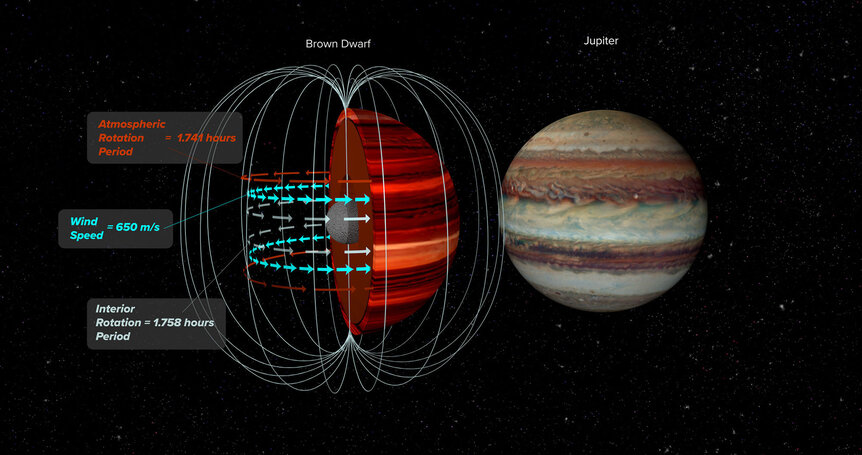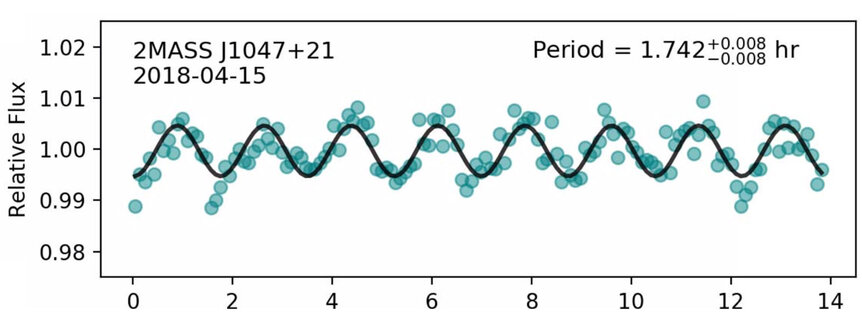Create a free profile to get unlimited access to exclusive videos, sweepstakes, and more!
On a brown dwarf 35 light years away, a gale force wind's a-blowin'

Measuring wind speed on Earth isn't terribly hard, in principle. Find someplace solid to stand, and use an anemometer. Boom. Done.
On a brown dwarf that's a little bit tougher. For one thing, there's no place to stand. For another, the nearest ones are many trillions of kilometers away. NOAA may not give you a grant for that.
But astronomers are clever folks, and for the first time figured out a way to do just that. And just like here on Earth, in principle it's not terribly hard.
A brown dwarf is an object more massive than a planet but less massive than a star. The mass range is about 13 to 80 times Jupiter’s mass. That’s the range where it can fuse deuterium, an isotope of hydrogen, and lithium; above the upper limit it can start to fuse regular ol' hydrogen, and an object that can do that is a proper star.
Like gas giant planets and stars, brown dwarfs don't have a surface per se, just gas that gets thicker and thicker as you go deeper toward its center. So there's no place to stand to measure wind speeds.
However, they do have features at the tops of their clouds like storms (think Jupiter's Red Spot). Even the closest brown dwarfs are too far to see something like that directly, but what you could do is very carefully measure its brightness over time. As the brown dwarf spins, the storm will rotate into and out of view and then back again, so you could calculate the rotation rate that way by the dwarf changes in brightness.
But that’s not the wind speed, because you don't know if the atmosphere rotates at the same speed as the layers beneath it. How can you measure that?
Another trick: Brown dwarfs have strong magnetic fields. Electrons whiz around these fields, circling around them like beads on a wire. When electrons move around like that they give off low energy light in the form of radio waves, which can be detected at Earth. You can look for periodicity in the radio waves that would indicate a rotation speed. And here's the fun part: Magnetic fields are generated deep inside a brown dwarf, in a sense anchored to them, so by measuring how long it takes the magnetic field to rotate once, you're measuring the rotation of those layers!
So: Take the period you measured for the top of the atmosphere, and subtract the period you measured for the deep layers using the magnetic field. Voila! That difference is due to wind speed, and tells you how fast the winds are blowing.
To try this, astronomers looked at the brown dwarf 2MASS J10475385+2124234 (2MASS J1047 to its friends). It's just over 34 light years away, close enough to make the needed measurements. Using Spitzer Space Telescope in 2017 to look for infrared fluctuations in the atmosphere, they got a rotation time of 1.741 ± 0.007 hours (which is pretty fast; Jupiter takes a little under 10 hours to spin once).
Using the Karl G. Jansky Very Large Array in the New Mexico desert, they measured a periodicity in the radio signal of 1.751 to 1.765 hours (unfortunately they couldn't nail it down better than that). But as you can see, there's a significant time difference between the atmospheric rotation and the deeper layers. That's the wind speed!
Well, oops, that's actually just a time difference. To turn that into a speed you need a distance (speed = distance covered / time). To do that they needed to make two assumptions: One is the size of the brown dwarf, and the other is that the feature they're measuring in the atmosphere is on or near the equator (if it's near the poles that changes the distance it travels as the dwarf rotates). Given what we know of brown dwarfs, that’s not a bad assumption. And we have pretty good models for how big they are given various characteristics.
They get a radius of 2MASS J1047 of 67,200 km (making it a little bit smaller than Jupiter; brown dwarfs tend to shrink as you add mass to them, weirdly). So, given all that, they calculate a wind speed for the brown dwarf of 650 ± 310 meters/second, or 2340 kilometers per hour (±1115).
That's a strong wind. I poked around; the fastest non-tornadic wind speed ever measured on Earth was just over 400 kph. In a tornado, it's probably around 500 kph.
On the brown dwarf, the wind blows significantly faster than that. If you tried to anchor yourself to some non-existent ground, it would be like standing in the most powerful tornado ever on Earth, except faster. All the time.
If you wonder what it would be like to be in such a wind, the short answer is sucky*, and the longer answer is: Go see what Randall Munroe wrote about it. Note that his essay is for 800 kph winds, which is a lot slower than what's going on with 2MASS J1047.
I live in Colorado, where we frequently get what are called Chinooks, or föhn winds, where air flowing over the Rockies creates very rapid downdrafts that hit the surface and then travel horizontally across the ground. When conditions are right we'll get hit by a 70 kph wind out of nowhere that rattles the house and scares the crap out of us.
I will never complain about them again.
*Well, blowy.





























